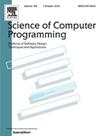Investigating quality aspects for UX evaluation of IoT-based applications in smart cities: A literature review
IF 1.4
4区 计算机科学
Q3 COMPUTER SCIENCE, SOFTWARE ENGINEERING
引用次数: 0
Abstract
The Internet of Things (IoT) has increasingly gained prominence in developing smart cities. IoT technologies are essential resources to make smart cities more efficient and sustainable. Recent research in Software Engineering (SE) has investigated the characteristics of IoT systems and the most appropriate approaches to their design and development. The development of systems based on IoT technologies enables a continuous flow of communication in the context of a smart city by allowing different systems to interact and adjust automatically to optimize the city's operation. In an urban environment, IoT connects a vast network of devices such as environmental sensors, public transportation systems, smart traffic lights, security cameras, and more. These characteristics make these applications complex and difficult to evaluate, particularly regarding User Experience (UX) design. Recently, we performed a rapid systematic review to examine the methods and practices commonly employed for evaluating the UX in these scenarios. In our previous work, we analyzed 43 studies covering different types of IoT-based applications and areas of smart cities. In this study, we extend our analysis by exploring which quality aspects have been considered for UX evaluation and categorizing the typical applications evaluated. Our findings revealed the need for more appropriate UX instruments to assess quality aspects that consider specific features of non-traditional interfaces (e.g., haptics, gesture, speech) and smart technologies within specific interaction contexts (e.g., smart environments based on ubiquitous computing). These instruments can be expanded from established guidelines or developed from scratch as long as they are validated in practice.
研究智能城市中基于物联网应用的用户体验评估的质量方面:文献综述
物联网(IoT)在智慧城市发展中日益突出。物联网技术是提高智慧城市效率和可持续发展的重要资源。软件工程(SE)最近的研究调查了物联网系统的特征以及设计和开发的最合适方法。基于物联网技术的系统开发,通过允许不同系统进行交互和自动调整,以优化城市的运行,从而在智慧城市的背景下实现连续的通信流。在城市环境中,物联网连接了大量的设备网络,如环境传感器、公共交通系统、智能交通灯、安全摄像头等。这些特征使得这些应用程序复杂且难以评估,特别是在用户体验(UX)设计方面。最近,我们进行了一次快速的系统回顾,以检查在这些场景中通常用于评估UX的方法和实践。在我们之前的工作中,我们分析了43项研究,涵盖了不同类型的基于物联网的应用和智慧城市领域。在这项研究中,我们通过探索用户体验评估中考虑的质量方面和对评估的典型应用程序进行分类来扩展我们的分析。我们的研究结果表明,需要更合适的用户体验工具来评估质量方面,考虑非传统界面的特定特征(例如,触觉、手势、语音)和特定交互环境中的智能技术(例如,基于普适计算的智能环境)。只要在实践中得到验证,这些工具可以从已建立的指导方针扩展或从零开始开发。
本文章由计算机程序翻译,如有差异,请以英文原文为准。
求助全文
约1分钟内获得全文
求助全文
来源期刊

Science of Computer Programming
工程技术-计算机:软件工程
CiteScore
3.80
自引率
0.00%
发文量
76
审稿时长
67 days
期刊介绍:
Science of Computer Programming is dedicated to the distribution of research results in the areas of software systems development, use and maintenance, including the software aspects of hardware design.
The journal has a wide scope ranging from the many facets of methodological foundations to the details of technical issues andthe aspects of industrial practice.
The subjects of interest to SCP cover the entire spectrum of methods for the entire life cycle of software systems, including
• Requirements, specification, design, validation, verification, coding, testing, maintenance, metrics and renovation of software;
• Design, implementation and evaluation of programming languages;
• Programming environments, development tools, visualisation and animation;
• Management of the development process;
• Human factors in software, software for social interaction, software for social computing;
• Cyber physical systems, and software for the interaction between the physical and the machine;
• Software aspects of infrastructure services, system administration, and network management.
 求助内容:
求助内容: 应助结果提醒方式:
应助结果提醒方式:


